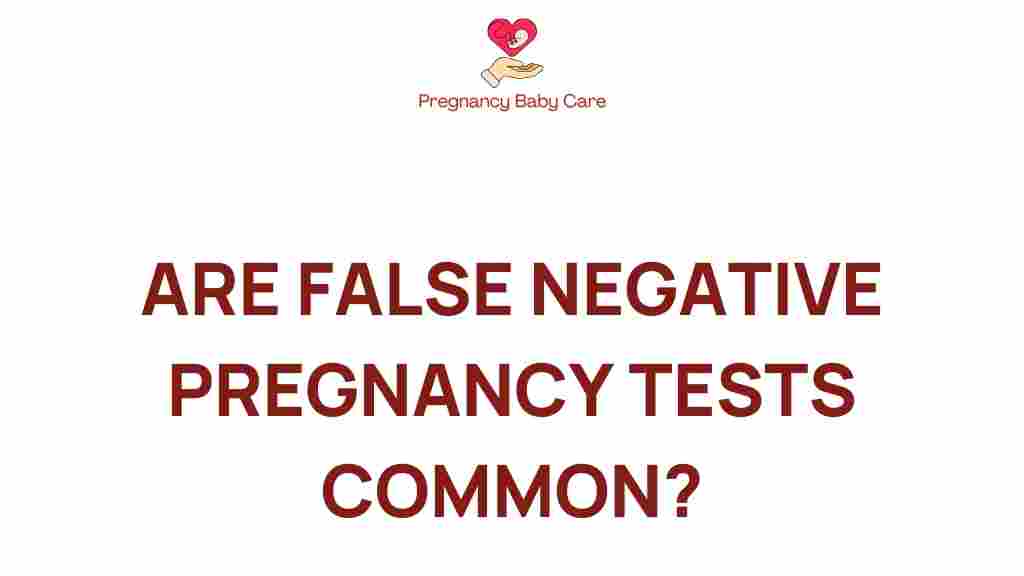Unveiling the Truth: Are False Negative Pregnancy Tests Common?
Pregnancy is a life-changing experience, filled with excitement, anticipation, and sometimes anxiety. One crucial aspect of this journey is testing for pregnancy, often through home pregnancy tests. However, a common concern among women is the accuracy of these tests, particularly regarding false negative pregnancy tests. In this article, we will explore the factors contributing to false negatives, how to ensure accurate results, and debunk some prevalent medical myths surrounding pregnancy testing.
Understanding False Negative Pregnancy Tests
A false negative pregnancy test occurs when the test indicates that a woman is not pregnant when, in fact, she is. This situation can be frustrating and confusing, especially for those eager to know if they are expecting. Understanding the reasons behind these inaccuracies is vital for women’s health and for managing expectations during early detection.
How Pregnancy Tests Work
Pregnancy tests work by detecting the hormone human chorionic gonadotropin (hCG) in a woman’s urine or blood. hCG is produced after a fertilized egg attaches to the uterus. Here’s how the process typically unfolds:
- Fertilization: After intercourse, sperm can fertilize an egg, leading to the formation of a zygote.
- Implantation: The zygote develops into a blastocyst and implants itself into the uterine lining, triggering hCG production.
- Testing: Home pregnancy tests are designed to detect hCG levels, generally becoming positive about a week after a missed period.
Factors Leading to False Negative Results
Several factors can contribute to false negative pregnancy tests. Understanding these can help women take the necessary precautions to ensure accurate readings:
- Timing of the Test: Testing too early can lead to a false negative. It is best to wait until the first day of a missed period for the most reliable results.
- Hormonal Factors: Individual hormonal levels can vary significantly. Some women may not produce enough hCG at the early stages of pregnancy.
- Testing Method: Not all pregnancy tests are created equal. Sensitivity varies, with some tests able to detect lower levels of hCG than others.
- Improper Use: Failing to follow the instructions provided with the test can lead to incorrect results. This includes factors like using expired tests or not waiting long enough to read the results.
- Diluted Urine: If a woman has consumed a lot of fluids before taking the test, her urine may be too diluted to detect hCG accurately.
Common Pregnancy Symptoms
Recognizing pregnancy symptoms can be helpful in conjunction with testing for pregnancy. Some common signs include:
- Missed Period: Often the first sign of pregnancy.
- Nausea: Frequently referred to as morning sickness, this can occur at any time of day.
- Breast Changes: Tenderness or swelling in the breasts is common.
- Fatigue: Increased fatigue can be an early indication of pregnancy.
- Frequent Urination: Increased urination can occur as pregnancy progresses.
Step-by-Step Guide for Accurate Pregnancy Testing
To minimize the chances of false negative pregnancy tests, follow this step-by-step guide:
- Choose the Right Test: Select a high-sensitivity pregnancy test for early detection.
- Timing: Wait until the first day of your missed period for the most accurate results.
- Follow Instructions: Carefully read and follow the instructions provided with the test kit.
- Use First Morning Urine: The first urine of the day contains the highest concentration of hCG.
- Wait for Results: Allow the recommended time before reading the results to avoid misinterpretation.
Troubleshooting Tips for False Negatives
If you suspect a false negative result, consider these troubleshooting tips:
- Wait a Few Days: If the test is negative but you still suspect pregnancy, wait a few days and test again.
- Consult a Healthcare Provider: If you continue to get negative results but have pregnancy symptoms, seek medical advice.
- Utilize Blood Tests: A blood test conducted by a healthcare professional can provide a more definitive answer.
Debunking Medical Myths Related to Pregnancy Testing
Many myths surround pregnancy and testing accuracy. Here are some prevalent misconceptions:
- Myth 1: You can’t be pregnant if you have your period.
Truth: Some women experience light bleeding during pregnancy, which can be mistaken for a period. - Myth 2: Home pregnancy tests are always accurate.
Truth: While they are generally reliable, false negatives can occur due to various factors. - Myth 3: You cannot get pregnant while breastfeeding.
Truth: It is possible to conceive while breastfeeding, especially after the initial postpartum period.
Importance of Women’s Health Awareness
Understanding false negative pregnancy tests and the factors affecting them is essential for women’s health. It empowers women to make informed decisions about their reproductive health. Regular check-ups and open discussions with healthcare providers can enhance understanding and management of pregnancy-related issues.
For more information on women’s health and pregnancy, visit WomensHealth.gov.
Conclusion
False negative pregnancy tests can be a source of confusion and concern for many women. By being aware of the factors that contribute to these inaccuracies, understanding the testing process, and recognizing common pregnancy symptoms, women can better navigate the journey of pregnancy. Remember, if in doubt, consulting a healthcare provider is always a prudent choice. Empower yourself with knowledge and take charge of your reproductive health!
For further reading on pregnancy testing and women’s health, check out our article on Understanding Pregnancy Symptoms.
This article is in the category Pregnancy and created by PregnancyBabyCare Team
